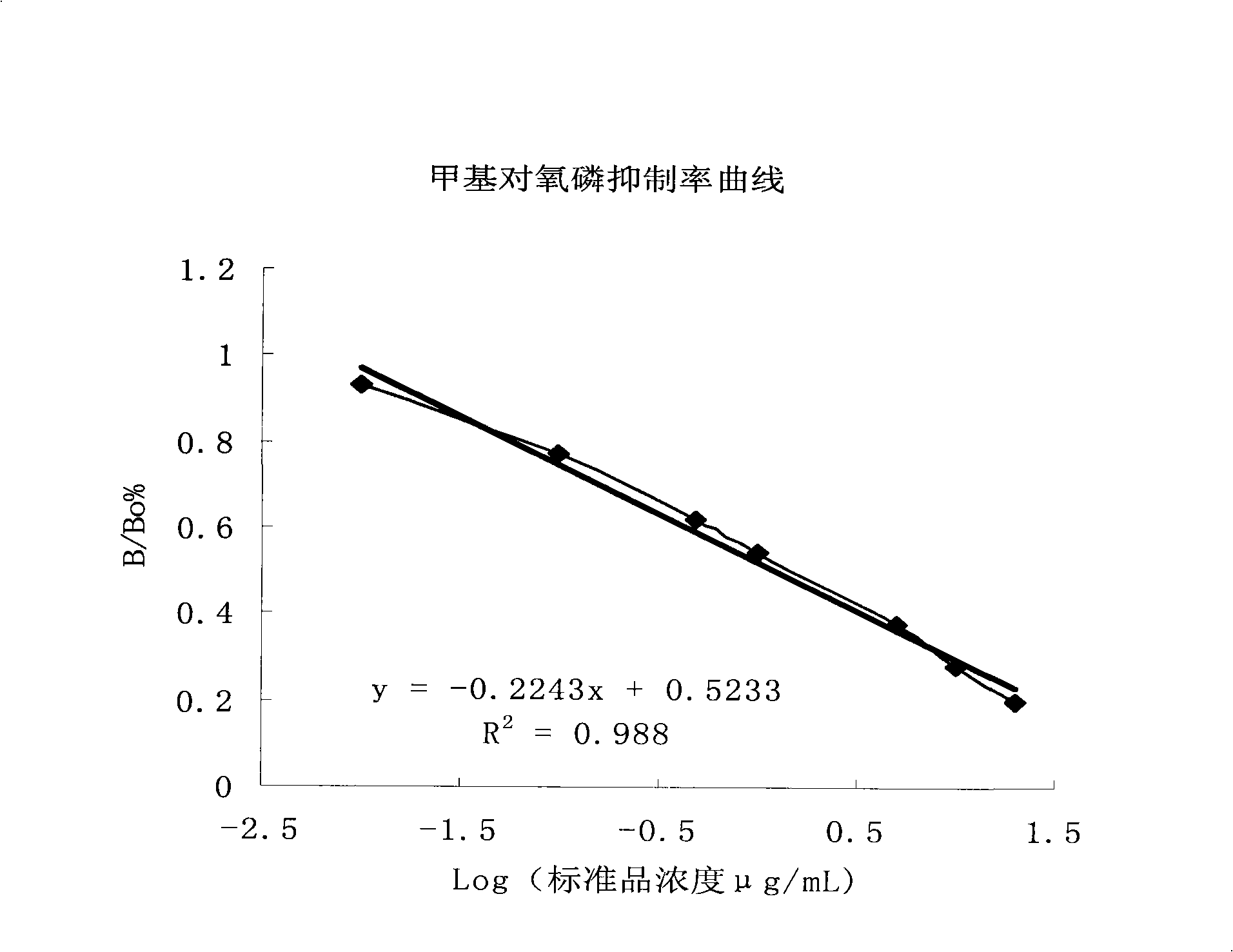Methyl paraoxon enzyme-linked immunosorbent assay method
An enzyme-linked immunosorbent assay and methyl paraoxon technology, applied in the field of immunoassay, can solve the problem of lack of detection and establishment of ELISA method, and achieve the effects of high selectivity and sensitivity, low cost, good stability and repeatability
- Summary
- Abstract
- Description
- Claims
- Application Information
AI Technical Summary
Problems solved by technology
Method used
Image
Examples
Embodiment 1
[0052] Embodiment 1, the steps of indirect competition ELISA experimental method are as follows:
[0053]The methyl paraoxon standard was prepared in advance into a 1000 μg / mL methanol solution as a working mother solution, and stored at 4°C until use. Prepare PBST solution (0.01mol / L, pH7.4, 0.15mol / L NaCl, 0.5% Tween-20), and prepare a series of reaction solutions based on this to dilute competitor standard solution and antiserum.
[0054] a. Coating: Coat the enzyme-linked reaction plate with the coating agent at a set concentration, 100 μL / well, overnight at 4°C.
[0055] b. Washing: Wash the reaction plate three times with PBST, 3 min each time, 200 μL / well, and then spin dry the reaction plate.
[0056] c. Blocking: CBS containing 0.1% gelatin, 200 μL / well. Blocking at 37° C. for 2 hours.
[0057] d. Washing: Same as b
[0058] e. Competition: Dilute the methyl paraoxon mother solution into 0.01μg / mL, 0.1μg / mL, 0.5μg / mL, 1μg / mL, 5μg / mL, 10μg / mL, 20μg / mL series with st...
Embodiment 2
[0065] Embodiment 2, actual sample detection
[0066] Take the negative sample (cotton) as a representative sample, cut it to about 5mm×5mm, and mix well. Weigh 1.0g samples respectively and place them in 100mL conical flasks with stoppers, then add a certain concentration of methyl paraoxon standard acetone solution to it, so that the final concentration of methyl paraoxon in cotton is 0.1 μg / g, 1μg / g, 10μg / g, stand at room temperature for 15min. Add 20mL ethyl acetate to the Erlenmeyer flask, extract in an ultrasonic generator for 20min, and filter the extract. The residue was then ultrasonically extracted with 10 mL of ethyl acetate for 5 min, and the two filtrates were combined. Concentrate the filtrate to near dryness in a water bath rotary evaporator at 40°C, dissolve it with acetone and adjust the volume to 1 mL, then dry it with nitrogen, dissolve it in PBS containing 10%-20% methanol, and use it for ELISA detection; Oxonphosphorus has a certain degree of hydrophobi...
Embodiment 3
[0067] Embodiment 3, determination of recovery rate and sample extraction method
[0068] Take the negative sample (cotton) as a representative sample, cut it to about 5mm×5mm, and mix well. Weigh 1.0g samples respectively and place them in 100mL conical flasks with stoppers, then add a certain concentration of methyl paraoxon standard acetone solution to it, so that the final concentration of methyl paraoxon in cotton is 0.1 μg / g, 1μg / g, 10μg / g, stand at room temperature for 15min.
[0069] Add 20mL ethyl acetate to the Erlenmeyer flask, extract in an ultrasonic generator for 20min, and filter the extract. The residue was then ultrasonically extracted with 10 mL of ethyl acetate for 5 min, and the two filtrates were combined.
[0070] Concentrate the filtrate to near dryness in a 40°C water-bath rotary evaporator, dissolve it with acetone and make the volume to 1 mL, then dry it with nitrogen, and dissolve it in PBS containing 10-20% methanol.
[0071] Pipette 50 μL of the...
PUM
| Property | Measurement | Unit |
|---|---|---|
| Sensitivity | aaaaa | aaaaa |
Abstract
Description
Claims
Application Information
 Login to View More
Login to View More - R&D
- Intellectual Property
- Life Sciences
- Materials
- Tech Scout
- Unparalleled Data Quality
- Higher Quality Content
- 60% Fewer Hallucinations
Browse by: Latest US Patents, China's latest patents, Technical Efficacy Thesaurus, Application Domain, Technology Topic, Popular Technical Reports.
© 2025 PatSnap. All rights reserved.Legal|Privacy policy|Modern Slavery Act Transparency Statement|Sitemap|About US| Contact US: help@patsnap.com



